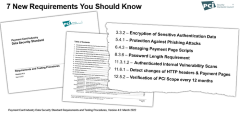

A Merchant’s Guide to Payment Optimization
Whether you operate a brick-and-mortar and/or online shop, ensuring your payment system is optimized can considerably impact your bottom line. The payment methods you accept, processing fees you incur, fraud prevention measures you use, and more, can all affect your transaction authorization rates, brand reputation and the cost of accepting payments.
Investing the time and resources in payment optimization can streamline your processes, help your business avoid costly penalties and fees and ensure your customers have excellent experiences that keep them returning.
What is payment optimization?
Payment optimization is both a task and an opportunity—a chance to reassess your payment methods, processes and technology to ensure you aren’t overspending and that your processes are as smooth as possible.
But optimizing your payments does more than just reduce your costs; it can also limit your exposure to costly fraud and ensure that more transactions are completed, boosting your overall revenue. At Payway, we focus on three key areas to optimize payments to help your business thrive:
| Payment Efficiency | Cost-Effectiveness | Customer Experience |
|---|---|---|
| Authorization Rate Improvement | Cost-Plus Pricing | Recurring Payments Support |
| Payment Option Expansion | Level 3 Processing | Customer Payment Recovery |
| Fraud Protection Enhancement | Decline Code & Retry Advice | Account Updater |
| Payment Security |
So, how can you determine the right optimization strategies for your business? To address each of the three areas, we recommend that you first take a close look at:
- Your current payment options
- Opportunities to reduce the cost of accepting payments
- Ways to improve authorization rates
- Customer retention methods
- Security and fraud prevention measures
- Data and insights from your payment gateway
Expanding Payment Options
Payment method options are crucial in payment optimization, extending beyond simply accepting more credit card types. It’s about enhancing customer convenience by offering alternative payment methods, such as wallets and ACH, which allows more customers to complete their purchases quickly and easily. However, given the prevalence of card payments, why do you need to offer more payment options?
Reduced Cart Abandonment: 60% of online shoppers say they will abandon their cart if their preferred payment method isn’t accepted.[1] When customers can pay with their preferred method, they’re more likely to complete their purchase, reducing your overall cart abandonment and churn.
Attract More Customers: Offering alternative payment methods can help customers with different financial situations (like younger customers or those without credit) complete their purchases successfully.
Promote Customer Retention: Enhancing convenience for customers with expanded payment options cultivates loyalty and helps attract repeat customers.
Improved Cash Flow: Digital wallet payments are fast, secure and convenient, allowing funds to be transferred to your merchant account more quickly.
Reducing Costs
The technology required to accept and manage credit card, ACH, and other payments is complex. It has strict PCI-DSS security requirements that must be regularly maintained and updated to meet evolving technological standards and implement new cybersecurity best practices. Payment gateways and card networks pass the costs of maintaining and updating these networks onto merchants through interchange, payment gateway, and processor fees.
Part of optimizing your payment processes is ensuring you’re not overspending on the technology you need. Begin by closely examining what you pay for, its value and how you can cut costs.
Typical Payment Processing Fees
- Interchange fees are charged by the card network and cover the cost and risk of processing a transaction. They fluctuate based on the type of transaction (in-person, online, card-not-present, etc.), card type and other factors.
- Payway Gateway fees are charged by the payment gateway for securely transmitting transaction data between the merchant, payment processor, and banks. It may also include fees for value-added services.
- Processor fees are charged by the payment processor to facilitate the transaction between the customer and the merchant. This is usually a markup paid on top of the interchange fee.
As a merchant, you may encounter additional monthly costs, setup fees and batch processing fees, depending on your payment partners and business structure. We recommend reviewing these factors annually to ensure your business gets the best deal.
Not All Fees are Set in Stone
There are a lot of factors that impact the cost of accepting payments. Get help untangling what fees are fixed and which can be reduced with a free cost analysis from Payway. We’ll help you confirm whether you’ve got the best deal — even if it’s not with us!
Strategies to Reduce Payment Processing Fees
Fortunately, there are a few ways to reduce your transaction costs, including Level 3 processing, cost-plus pricing, and cash discounts.
Level 3 card processing retrieves and transmits more detailed transaction information than level 1 or 2 to the issuing bank, lowering the risk of that transaction. For commercial and government organizations, this information is crucial for payment security and record-keeping and allows these organizations to reduce their interchange rates. At Payway, Level 3 processing is automated for all clients, ensuring every transaction is as inexpensive and secure as possible.[2]
Cost-plus pricing is the most transparent and cost-effective way to process credit card payments. It can reduce monthly credit card processing fees by up to 20%. Unlike bundled pricing, merchants pay the actual interchange rate based on the card type plus a markup.
A Cash Discount Program allows business owners to offset up to 100% of their processing fees.
“While cash discounts are common for in-person transactions, no one was offering a true solution for eCommerce or recurring payments. We figured out a way to do it to give our customers a viable option based on their business model.”
– Kimberly Miller, EVP of Strategy and Operations, Payway
Improve Authorization Rates
Over half of customers will abandon a purchase when their payment fails and, for businesses, that translates into substantial lost revenue. Reducing declines, chargebacks and other authorization issues are critical for optimizing your payment processes.
Strategies for Authorization Rate Improvement
Implement Optimal Retry Strategies
The first step in determining what caused a failed payment is to check the decline code provided by your payment processor. A card decline code is typically a two-digit, alphanumeric error code that explains why a card transaction was declined. Payway provides universal decline reasons for specific decline codes to help decide which transactions to retry. In addition, this data helps businesses comply with Visa’s Excessive Reattempts Rule – which, if not met, is subject to excessive reattempt fees per transaction.
Transform Payment Declines into Positive Experiences
Say your online store is pulling in $10 million annually. With a 10% decline rate, you’re missing out on an extra $1 million. Customer Payment Recovery ensures transactions go through smoothly when payment issues arise. When payments fail, customers are given the option to complete the purchase and be charged later. Not only does this reduce decline rates and payment failures, it can increase revenue by up to 15%.[3]
Automatically Update Credit Card Information
Cards constantly expire or become deactivated, affecting revenue and authorization rates for businesses that use a card on file or operate with a subscription-based model. Fortunately, Account Updater and Amex Cardrefresher, automatically query card companies to refresh card information and ensure recurring payments continue.
Prevent Chargebacks Before They Occur
When a customer disputes a transaction directly with their bank to obtain a refund, they initiate a chargeback. Often, chargebacks arise because a customer doesn’t recognize a charge, forgot they subscribed to a service or aren’t satisfied with what they paid for.
Chargebacks are also a common tactic used by fraudsters. Bad actors frequently file chargebacks to recover funds for illegitimate reasons. This friendly fraud strategy is becoming more common as social media influencers promote it as a method to reclaim money while still receiving products and services.
Subscription-based businesses face frequent chargebacks due to accidental sign-ups, forgotten subscriptions and unrecognized recurring charges. Read our blog, “Chargeback Defense: Protecting Your Subscription Business,” to discover effective strategies for managing and preventing chargebacks.
Unfortunately, chargebacks can create significant losses for businesses, whether they are legitimate or not. Since these transactions are processed directly through the bank instead of the company, the burden of proving that adequate goods and services were provided rests on the business. Merchants win only about 42% of chargeback disputes.[4]
Taking a proactive approach to reduce chargebacks can improve your authorization rates and bottom line.
Strategies to Reduce Chargebacks and Improve Authorization Rates
- Ensure terms and conditions are clear and easy to read
- Offering an easy and accessible cancellation process can deter customers from resorting to chargebacks out of frustration. Whether it’s monthly or yearly, allowing customers to cancel without hurdles can improve satisfaction and reduce disputes.
- Provide customers with a purchase confirmation for every transaction, including recurring payments. Ensure the billing descriptor clearly identifies the transaction so it is recognizable.
- Send timely renewal reminders to avoid chargebacks from unrecognized charges
- Respond quickly to customer concerns so minor issues don’t result in chargebacks
Fraud Prevention and Security
Chargebacks and other types of fraud can also be mitigated by ensuring secure payment processing. Your payment solution should include these essential security features:
- Tokenization and Vault Technology: Sensitive credit card data is replaced with unique tokens, rendering them useless to hackers if intercepted. This significantly reduces the risk of exposing customer information. Tokenization is among the most effective payment security measures, with global tokenized transactions expected to reach 1 trillion by 2026.
- Point-to-Point Encryption (P2PE): Encrypts payment data before it leaves the customer’s browser, securing it during processing and transmission. This ensures that intercepted information remains unreadable. P2PE also minimizes your business’s exposure to customer data, reducing security risks and PCI-DSS compliance scope.
- Fraud Detection: Advanced fraud prevention tools continuously monitor transactions, accounts, and websites for suspicious activity using pattern recognition, machine learning, and real-time analysis, helping to stop fraud before it happens.
Leverage Payment Reporting
Optimizing a payment strategy requires data-driven decision-making. Businesses can leverage various payment reports to improve efficiency, reduce costs, and enhance customer experiences. Here are key types of reports and why they matter:
- Transaction Reports
What it provides: A detailed breakdown of all transactions, including volume, payment methods, success rates, and declines.
Why it’s useful: Allows businesses to identify trends, preferred payment methods, and peak transaction times to optimize payment processing and cash flow.
- Decline & Failure Reports
What it provides: Insight into failed transactions, including decline reasons (e.g., insufficient funds, expired cards, fraud triggers).
Why it’s useful: Enables businesses to take corrective actions like automatic retries, customer notifications, and alternative payment methods to improve approval rates.
- Chargeback & Dispute Reports
What it provides: A record of chargebacks, dispute reasons, and resolution outcomes.
Why it’s useful: Helps businesses spot fraud patterns, improve dispute management, and implement policies to reduce chargebacks.
- Interchange & Processing Fee Reports
What it provides: A breakdown of processing costs, including interchange fees, assessment fees, and processor markups.
Why it’s useful: Enables cost analysis by card type and transaction method, allowing businesses to negotiate better rates or adjust their payment acceptance strategy.
With comprehensive reporting, you can continually optimize payments and uncover areas for improvement.
Optimize Subscription Payments
While many of the processes for traditional and subscription-based businesses are the same, completing recurring transactions can present some unique challenges when optimizing payment processes.
If your business operates on a subscription model, you need automated payment systems designed to streamline recurring payments, manage transaction failures and support the predictable revenue you rely on. As you assess your payment processes, ensure your subscription payment gateway offers features previously mentioned, including
- Payment retry advice
- Clear billing descriptors to limit chargebacks
- Level 3 processing to lower processing fees
- Account Updater for expired or changed card numbers
Consult with the Experts
So many variables influence a business’s payment needs, making the task of payment optimization a daunting challenge at best. Whether you’re new to accepting payments or looking to evaluate solutions you’ve had in place, Payway is here to assist. Our concierge support team is available to conduct a free cost analysis, answer questions and help you identify the right strategies to optimize your payment processes. By focusing on factors that enhance your customers’ experiences, save money and provide greater efficiency across your payment-related processes, you can attract and retain more customers while boosting your overall returns.
[1] Checkout.com (2024). How to Choose the Right Payment Methods.
[2] Mastercard (n.d.). Level 2 and 3 Data.
[3] Payway (n.d.). Customer Payment Recovery.
[4] Chargebacks 911 (2025). Chargeback Win Rate: How to Calculate Your Win Rate, Plus Tips to Keep Chargeback Issuances as Low as Possible


